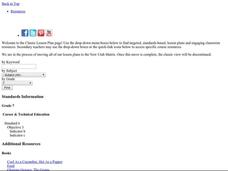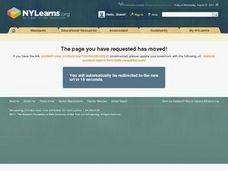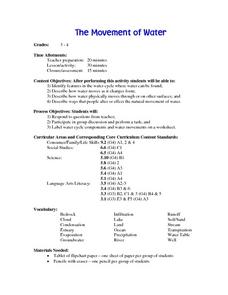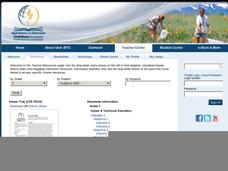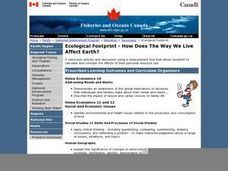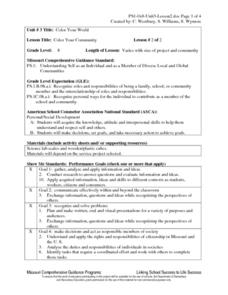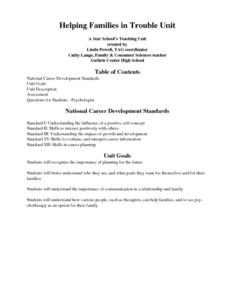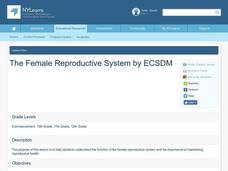Curated OER
The Quicker the Better? Food Processing
Kids explore food choices, nutrition, and agriculture through a variety of sources and activities. They research unknown words on food labels, test the salt content in canned vs non-canned foods, and discuss processed foods. The lesson...
Curated OER
The Male Reproductive System
Learners identify the parts of the male reproductive system. They explore the functions of the male reproductive system. Students demonstrate the connection between reproductive health and the ability to reproduce. Learners prepare...
Curated OER
The Circulatory System--Part III
Students research the process for the preparation of a soup. Students explore the safety issues of food preparation. Students, after presenting their soups to the class, will eat their soups that they have prepared.
Curated OER
Credit - Good? Bad?
Students examine credit cards. They explore the detrimental effects that result from debt and poor credit. Students analyze interest rates, minimum balances, and consumer debt. Students survey the benefits of credit cards.
Curated OER
The Movement of Water
Here is an excellent lesson plan on the water cycle and the states in which water exists. Learners identify the features of the water cycle, describe how water changes form, and look at ways that people affect the natural movement of...
Curated OER
DNA: Expressions in Agriculture
What is DNA extraction, and can you make a living doing it? Yes, if you are in a biotechnology field. Kids learn about DNA extraction, GMOs, and biotechnology careers. They then watch videos and complete activities to understand the use...
Curated OER
Career Trek: Agricultural Careers
What is agriscience and could it hold a potential career opportunity? Learners define agriscience and explore careers that involve both agriculture and natural resource fields. The activity includes several web links, a game, a full...
Curated OER
The 1950s:
Teens will get a kick out of this presentation, which provides a glimpse of the consumerism and rising pop culture of 1950's America. They will especially appreciate the discussion of "Teen culture" including the music of Elvis, the...
Curated OER
Oil Consumption
Pupils explore the concept of environmental stewardship. In this science lesson, students calculate the barrels of oil that their family consumes in a year.
Curated OER
The Circulatory System - Part II
First graders recognize that the heart muscle requires food. Students observe a Venn Diagram to identify foods that are good for them. Students provide one ingredient to make healthy heart soup.
Curated OER
The Female Reproductive System
Students research female reproductive issues. They create a presentation, in small groups, that focuses on one particular helath issue involving the female repro=ductive system.
Curated OER
EBT-rimental
Students engage in a lesson that gives them the tools needed to become knowledgeable credit consumers. The companion website for the ITV program TV-411 is used to provide learners with an interactive experience of what credit has to offer.
Curated OER
Classroom and Laboratory Management Pre Assessment
Students will learn the meaning of food science and management for the classroom and laboratory. Background For Teachers: NOTE TO TEACHERS: A pre-assessment should never be graded. Good pre-assessment devices, however, can also be used...
Curated OER
Sexual Health and Hygiene
By examining harmful health and hygiene practices, teens will be able to determine what is best for their body. Advertisers for health/hygiene products will also be evaluated for "best interest" criteria. The class will begin by...
Curated OER
Ecological Footprint--How Does The Way We Live Affect Earth?
Students demonstrate an awareness of the global implications of decisions that individuals and families make about their needs and wants. They identify environmental and health issues related to the production and consumption of food....
Curated OER
Color Your Community
Eighth graders identify the self as an individual and as a member of a diverse local and global community. They recognize roles and responsibilities of being a family, school, or community member and the interrelationship of roles and...
Curated OER
Helping Families in Trouble Unit
Students discover the importance of planning for the future and examine what goals they want for themselves and for their families. They also explore the importance of communication in a family, their views of therapy, and ways a...
Curated OER
The Female Reproductive System
Learners identify the different parts of the female reproductive system. For this health science lesson, students explain the functions of each part. They research Female Reproductive Health Issue and share their findings in class.
Curated OER
Carbohydrates, Proteins, and Fats
Students describe the properties of carbohydrates, proteins and fats. In this health science lesson, students identify food sources where these nutrients can be found. They explain how they affect our body.
Curated OER
Puberty
Eighth graders describe the changes their body undergoes during puberty. In this health science lesson, 8th graders explain how the hypothalamus and pituitary gland play a major role in the process. They identify the different parts of...
Curated OER
The Male Reproductive System
Students name the different parts of the male reproductive system. In this health science activity, students research health issues affecting the male reproductive system. They create a presentation and share it to class.
Curated OER
What is Health?
Eighth graders identify the three aspects of health and wellness. In this health science lesson, 8th graders analyze how certain events in their life affect their health. They share their insights to class.
Curated OER
Flambe Elements
Eighth graders discuss atoms and electrons as well as atoic structure. They view atomic structure via the computer. Students watch a demonstration in which the teacher demonstrates glass tubing turning yellow in a Bunsen Burner flame....
Curated OER
Why Is My Bread Fuzzy?
Students explore the organisms that live on counters or surfaces in the classroom. In this mold experiment, students observe mold in different conditons. Students record their observations on a worksheet. Students understand how...
